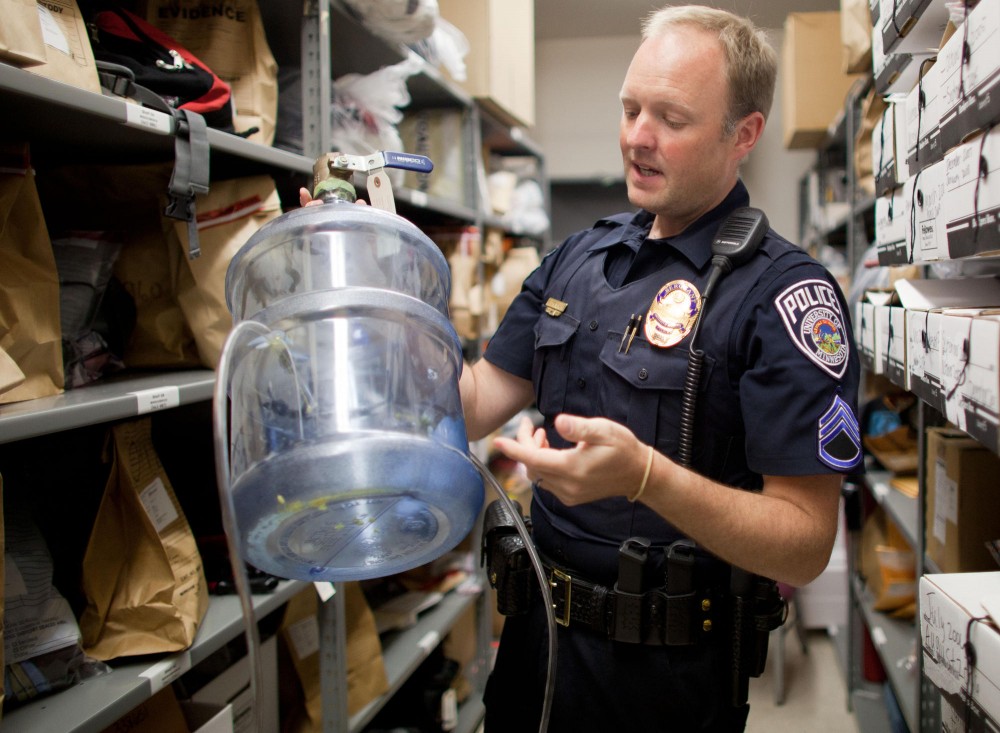Steel shelves stuffed with boxes of electronics, drugs and guns line the walls of a small room. Another 8-foot tall shelf runs through the middle, leaving 3-foot aisles on either side.
The room, tucked away into the Transportation and Safety Building, is well-lit and fairly dust-free, despite holding a wide array of materials from criminal cases, some more than eight years old.
Each individual shelf is labeled, and the items that sit on them are marked with barcodes.
The bedroom-sized space is a warehouse of evidence, and a temporary home for lost, stolen and confiscated goods on campus that are turned into University police daily.
âÄúMaterials can find their way here by all different means,âÄù Sgt. Erik Stenemann said as he walked between the overflowing shelves. âÄúWeâÄôve had people come in here and turn in coffeemakers.âÄù
Recovered items sit on the shelves anywhere from 60 days to indefinitely. When officers seize or recover property, they bring it into University police headquarters and place it into a locker that can only be accessed from within the recovered properties room.
Only Stenemann and two other officers have keycards to the room.
Stenemann or one of his co-workers log each item into a computer database and connect it to the officer that seized the property.
ThatâÄôs just one safeguard to ensure that officers wonâÄôt get into trouble if an item goes missing, Stenemann said. Any weapons seized are categorically logged into the computer system, and cash is placed into a safe for which no University officers have the combination.
âÄúOnly our accountant can access that safe,âÄù Stenemann said. âÄúI have no idea how much money is in there.âÄù
Barrels and shelves
Identification cards and wallets âÄî some of the most common items turned into University police âÄî are kept for up to 60 days. Lost and forgotten backpacks take up an entire shelf in the properties room.
One shelving unit in a far corner emits a slight smell of marijuana. Each of its five shelves hold confiscated illegal drugs and paraphernalia, often seized in small amounts from University students or people passing through the campus area.
One evidence bag in the middle of the shelf held about a pound of marijuana.
All illegal drugs are taken to a special location off-site to be incinerated after their previous owner has been charged, Stenemann said.
âÄúYou could imagine the smell after a few weeks if we didnâÄôt destroy them,âÄù Stenemann said, pointing at envelope after envelope filled with marijuana.
âÄúThings would get a little moldy.âÄù
The Minneapolis Police Department has auctions for many of the legal items crowding the shelves of their own recovered property rooms. But University police donâÄôt have that option due to policy restrictions, and often dispose of or donate property to the UniversityâÄôs ReUse program or the Ronald McDonald House Charities, University police Deputy Chief Chuck Miner said.
The fact that many of the items in the recovered properties room, such as iPods or cellphones, are never returned to their owners can get frustrating, Stenemann said.
âÄúPeople just need to take the time and write down serial numbers for any property over $50,âÄù Stenemann said.
Barrels filled with fake IDs, knives, guns, cellphones and other items are periodically burned as well. University police recently sent off a 50-gallon barrel drum filled with rifles and other seized firearms to be destroyed, Stenemann said.
Many of the items in the recovered property room are run-of-the-mill, day-to-day items that officers see, Stenemann said. Bolt cutters, used to break padlocks during crimes like bike thefts, are on almost every shelf. Laptops have become common. Weapons, ranging from baseball bats to knives and guns, have their own shelf that spills over onto its neighbor.
But University police find some items harder to explain. Stenemann showed three doll parts in an evidence bag âÄî an inexplicable part of a past burglary.
âÄúThis was collected during a bomb scare,âÄù Stenemann said as he kicked a red plastic container the size of a kitchen garbage can.
Stenemann pulled from a nearby shelf a five-gallon water cooler bottle drilled with holes: the âÄúsecond-most impressive bong in the world,âÄù he said. It was eclipsed only by a bong with a built-in motorized fan that once sat on the same shelf.
Larger items are stored in the University police garage. There are at least six bikes locked behind a fence gate along with a miniature motorcycle that had been abandoned after a careless driving incident.
A fridge in the garage contains biological samples like urine and semen, along with a drug called Khat that police officers throughout Minneapolis have seen more frequently in the past five years. Khat is an illegally imported plant leaf popular with East African populations.
âÄòA constant struggleâÄô
The amount of material has become a problem for the department, which has grown to at least 50 officers in an office meant to hold just 30, Stenemann said. With the capacity to handle more cases, the amount of material entering the recovered properties room has risen steadily, Miner said.
âÄúItâÄôs a constant struggle to keep up,âÄù Stenemann said. âÄúAnd itâÄôs only gotten busier and busier over the last decade.âÄù
Many of the items wonâÄôt leave the shelves for months, depending on what state law mandates. In unsolved felony cases, property must be kept for at least three years, Stenemann said. For certain felonies like cases of homicide and sexual assault, items may be kept almost indefinitely.
And the amount of evidence in those cases may be extensive âÄî investigators often collect clothing, carpet and bedding from a crime scene.
To combat the clutter, University police have begun burning video, audio and photographic evidence onto CDs, which Stenemann said has saved quite a bit of space in the small recovered properties room. But the change is fairly recent. The evidence from one case, which took place in 2003, still includes VHS cassettes.


